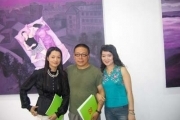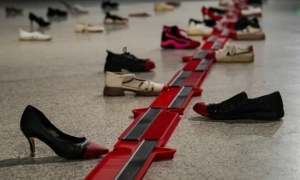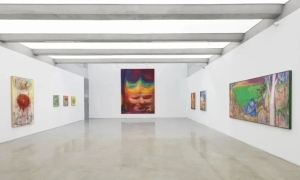一种后先锋主义
余极 Yu Ji,小芳和小芳的玩偶 Fang and Fang's Doll No.2,Photograph, 2007
>>>>>更多展览图片
出 品:千高原艺术空间
艺 术 家:陈亮杰、陈秋林、何工、蒋鹏、黎朗、刘玉洁、罗发辉、秦琦、沈小彤、舒群、孙学敏、肖克刚、余极、朱兵、赵晓佳
展览时间:2009年03月28日 --- 2009年05月05日
展览地点:千高原艺术空间 四川省成都市芳沁街87号 邮编:610041
开放时间:星期二至星期日10:30-19:00
电 话:+86-28 8512 6358 / 8515 8238
传 真:+86-28 8512 6358
邮 箱:info@1000plateaus.org / 1000plateaus.cn@gmail.com
网 址:www.1000plateaus.org
展览题目来自展出的艺术家舒群的作品《同一性语态:一种后先锋主义?》,展览展出了15位中国当代艺术家在各个时期创作的23件作品。选用“一种后先锋主义”做展览题目,旨在表达我们一贯的对思考、实验和前卫的尊重。
舒群创作于1993年的作品《同一性语态:一种后先锋主义?》延续了他在“八五”时期的理性绘画宣言;秦琦(《杨杰No.4》)因作品独特的思考特质和直接表达的绘画性而成为当今倍受注目的年轻艺术家;沈小彤1993年的“红色系列”作品(《一张脸No.1、2》)到1999年作品(《诱惑1999 No.3》)中传达的公共话题到个体表达的变化;游走于东西方文化之间的何工(《场合》)以知识分子的冷静激情展开对集体意志的个人表达;罗发辉(《一男一女》)在情色和欲望后面对伤害的迷恋;朱兵的作品(《梦园》)中我们看到高速发展变化的中国艺术家对精神家园的怀念。。。。。。在架上绘画以外,陈秋林2002年的作品(《。。。。。。No.3》)把女性对伤害的敏感置于高速发展的城市背景之中,由此开始艺术家的私人记忆与社会、环境、人民、城市之间的相互介入;黎朗(《彝人》)以纪实的手法、悲悯的情怀,通过相机对西南边陲封闭地区的彝人与土地进行长期冷静的观察,表现出那片土地上的和谐、尊严和神性。
A Certain Kind of Post-modernism
Director: A Thousand Plateaus Art Space
Artists: Chen Liangjie, Chen Qiulin, He Gong, Jiang Peng, Li Lang, Liu Yujie, Luo Fahui, Qin Qi, Shen Xiaotong, Shu Qun, Sun Xuemin, Xiao Kegang, Yu Ji, Zhu Bing, Zhao Xiaojia
Exhibition Time: March 28th-May 5th, 2009
Venue: A Thousand Plateaus Art Space, 87 Fang Qinjie, Chengdu
Opening Hours: Tuesdays to Sundays 10:30 to 19:00
Phone: +86-28 8512 6358 8515 8238
Fax: +86-28 8512 6358
Email: info@1000plateaus.org / 1000plateaus.cn@gmail.com
Web: www.1000plateaus.org
The title of this exhibition is derived from Shu Qun’s painting: Identity Voices: A Certain Kind of Post-modernism?. The exhibition brings twenty-three works of fifteen artists from different periods in the history of Chinese contemporary art. The choice for A Certain Kind of Post-modernism as the exhibition topic reflects our continuous preoccupation with experimental and avant-garde art creations.
The work by Shu Qun Identity Voices: A Certain Kind of Post-modernism? painted in 1993 is a continuation of the painter’s reflection on ‘Rational Painting’ in the ’85 period. Qin Qi is a young artist whose independent reflection and direct painting technique visible in the work Yang Jie No.4 make him one of the leading artists in today’s China. The time span from Face No.1/2 of the Red Series of Shen Xiaotong painted in 1993 to Temptation No.3 in 1999 reflects a change from the expression of a public subject matter to the rendering of individual emotions. Traveling frequently between Western and Eastern Culture, the artist He Gong in The Occasion reveals a collective consciousness through a distant but at the same time passionate brush stroke. Luo Fahui expresses his infatuation with pain and distress behind layers of lust and desire. In Dream Garden by Zhu Bing we can see the nostalgic longing of the artist trying to find a spiritual haven in a highly urbanized environment.
In Ellisis (2002), Chen Quilin places the sweet suffering of young people against the background of high-speed urbanization. Her later works continue the exploration of her personal memories in relation to social, environmental and urban problems. Through his photographic lens, Li Lang observes the Yi minority in south western China. His approach is detached yet full of compassion and gives expression to the harmony, dignity and divinity of the Yi people for their earth.
【编辑:贾娴静】






















